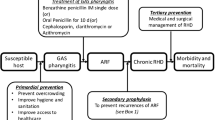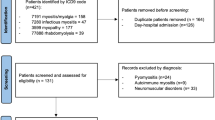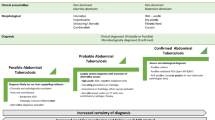Abstract
Objective
To study the clinical and laboratory profile of pediatric scrub typhus in rural south India.
Methods
This is a descriptive study of the clinical and laboratory features of 117 children with IgM ELISA proven scrub typhus out of 448 children, who were admitted in the Pediatric ward of a tertiary care hospital, during the study period of November 2014 through March 2015.
Results
Fever was present in all 117 children, with mean duration of fever at admission as 9 d. Gastrointestinal tract was the most commonly affected system, seen in 51 % of children. Cough (82 %), myalgia (70 %), vomiting (68 %), headache (45 %) and pain abdomen (42 %) were the most common symptoms of scrub typhus. Hepatomegaly (70), splenomegaly (53 %), pallor (50 %) and eschar (41 %) were the common clinical findings in children with scrub typhus. Out of 49 children with eschar, 32 were associated with regional lymphadenopathy, which was commonly seen in axillary, neck and groin regions. Leucocytosis (50 %), anemia (56 %), increased SGOT / SGPT (47 %), thrombocytopenia (41 %), hypoalbuminemia (40 %) and hyponatremia (40 %) were the common lab features. Shock (46 %), myocarditis (24 %) and pneumonia (16 %) were the common complications seen in these children. This study showed that early treatment for scrub typhus results in a good outcome in terms of early recovery and nil mortality.
Conclusions
Regional lymphadenopathy is a marker of hidden or developing eschar. Total count and differential count should be interpreted on the background of the duration of fever. Since IgM ELISA, which is diagnostic of scrub typhus may not be widely available, any febrile child coming from rural area with hepatosplenomegaly, pallor, eschar, generalised / regional lymphadenopathy, anemia, leucocytosis, thrombocytopenia and increased Aspartate transaminase (AST) /Alanine aminotransferase (ALT) should be started on empirical Doxycycline or Azithromycin in order to prevent life threatening complications secondary to delay in therapy.








Similar content being viewed by others
References
Kulkarni A, Vaidya S, Kulkarni P, Bidri LH, Padwal S. Rickettsial disease — an experience. Pediatr Infect Dis. 2009;1:118–26.
Stephen S, Kandhakumari G, Pradeep J, et al. Scrub typhus in South India: a re-emerging infectious disease. Jpn J Infect Dis. 2013;66:552–4.
Rathi N, Rathi A. Rickettsial infections: Indian perspective. Indian Pediatr. 2010;47:157–64.
Rathi NB, Rathi AN, Goodman MH, Aghai ZH. Rickettsial diseases in Central India: proposed clinical scoring system for early detection of spotted fever. Indian Pediatr. 2011;48:867–72.
Chanta C, Chanta S. Clinical study of 20 children with scrub typhus at Chiang Rai regional hospital. J Med Assoc Thai. 2005;88:1867–72.
Sittiwangkul R, Pongprot Y, Silviliarat S, Oberdorfer P, Jittamala P, Sirisanthana V. Acute fulminant myocarditis in scrub typhus. Ann Trop Paediatr. 2008;28:149–54.
Chogle AR. Diagnosis and treatment of scrub typhus—the Indian scenario. J Assoc Physicians India. 2010;58:11–2.
Watt G, Parola P. Scrub typhus and tropical rickettsioses. Curr Opin Infect Dis. 2003;16:429–36.
Mahajan SK, Rolain JM, Sankhyan N, Kaushal RK, Raoult D. Pediatric scrub typhus in Indian himalayas. Indian J Pediatr. 2008;75:947–9.
Varghese GM, Abraham OC, Mathai D, et al. Scrub typhus among hospitalised patients with febrile illness in South India: magnitude and clinical predictors. J Infect. 2006;52:56–60.
Razak A, Sathyanarayanan V, Prabhu M, Sangar M, Balasubramanian R. Scrub typhus in southern India: are we doing enough. Trop Dr. 2010;40:149–51.
Amano K, Suzuki N, Hatakeyama H, et al. The reactivity between rickettsiae and weil-felix test antigens against sera of rickettsial disease patients. Acta Virol. 1992;36:67–72.
Kumar M, Krishnamurthy S, Delhikumar CG, Narayanan P, Biswal N, Srinivasan S. Scrub typhus in children at a tertiary hospital in southern India: clinical profile and complications. J Infect Public Health. 2012;5:82–8.
Palanivel S, Nedunchelian K, Poovazhagi V, Raghunadan R, Ramachandran P. Clinical profile of scrub typhus in children. Indian J Pediatr. 2012;79:1459–62.
Vivekanandan M, Mani A, Priya YS, Singh AP, Jayakumar S, Purty S. Outbreak of scrub typhus in Pondicherry. J Assoc Physicians India. 2010;58:24–8.
Mathai E, Rolain JM, Varghese GM, et al. Outbreak of scrub typhus in southern India during the cooler months. Ann N Y Acad Sci. 2003;990:359–64.
Jim WT, Chiu NC, Chan WT, et al. Clinical manifestations, laboratory findings and complications of pediatric scrub typhus in eastern Taiwan. Pediatr Neonatol. 2009;50:96–101.
Dass R, Deka NM, Duwarah SG, et al. Characteristics of pediatric scub typhus during an outbreak in the north eastern region of India: peculiarities in clinical presentation, laboratory findings, and complications. Indian J Pediatr. 2011;78:1365–70.
Digra SK, Saini GS, Singh V, Sharma SD, Kaul R. Scrub typhus in children in children: Jammu experience. JK Sci. 2010;12:95–7.
Patil D, Bidari LH, Tikare N, Revankar VA. Profile of rickettsial fever in children. Karnataka Pedicon, 2006, Conference Abstracts. Available at: http://www. pediatriconcall.com/fordoctor/conference_abtracts/karnataka_pedicon/profile_ricketsial_ fever_in_children.asp. Accessed on 15th July 2015.
Paris DH, Day NPJ. Tropical rickettsial infections. In: Farrar J, editor. Manson’s Tropical Diseases. 23rd edition. Philadelphia, USA: Elsevier Saunders; 2014. p. 182.
Contributions
DKN: Design, literature search, clinical studies, data analysis, statistical analysis, manuscript preparation, editing and review; AKA: Data acquisition, data analysis, statistical analysis, manuscript editing and review; RKK: Literature search, clinical studies, data acquisition, manuscript preparation and editing; RVD: Design, literature search, manuscript preparation, editing and will act as guarantor for the paper.
Author information
Authors and Affiliations
Corresponding author
Ethics declarations
Conflict of Interest
None.
Source of Funding
None.
Rights and permissions
About this article
Cite this article
Narayanasamy, D.K., Arunagirinathan, A.K., Kumar, R.K. et al. Clinico - Laboratory Profile of Scrub Typhus — An Emerging Rickettsiosis in India. Indian J Pediatr 83, 1392–1397 (2016). https://doi.org/10.1007/s12098-016-2171-6
Received:
Accepted:
Published:
Issue Date:
DOI: https://doi.org/10.1007/s12098-016-2171-6




